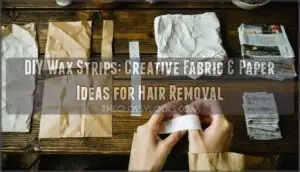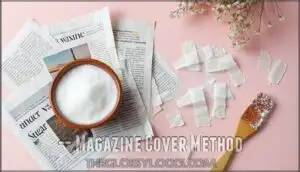This site is supported by our readers. We may earn a commission, at no cost to you, if you purchase through links.

Cut old cotton t-shirts into strips for flexible, reusable options that won’t irritate sensitive skin. Paper grocery bags work well too – they’re sturdy enough to grip hair but gentle on removal.
Magazine covers with glossy finishes create surprisingly effective strips that provide excellent adhesion. Each material offers different benefits, so you’ll want to match your choice to your skin type and hair texture.
The secret isn’t just picking the right material – it’s mastering the technique that transforms these everyday items into salon-quality tools, which can help you achieve the desired results with the right material.
Table Of Contents
- Key Takeaways
- Using Fabric for DIY Wax Strips
- — Reusing Old Clothing
- — Paper Bag Alternative
- — Magazine Cover Method
- Best Practices and Tips for DIY Wax Strips
- Frequently Asked Questions (FAQs)
- What can be used instead of wax strips?
- Can you make waxing strips at home?
- How can I wax my hair without wax strips?
- What wax can you use without strips?
- How long does homemade wax last before expiring?
- Can DIY wax strips be used on sensitive areas?
- Whats the ideal temperature for homemade waxing strips?
- Are there natural alternatives to sugar-based wax recipes?
- How to remove residue after using DIY wax strips?
- How long do homemade wax strips last?
- Conclusion
Key Takeaways
- You can create effective wax strips from materials you already have at home – old cotton t-shirts, paper grocery bags, and glossy magazine covers all work well and offer different benefits for various skin types.
- Fabric strips made from muslin or cotton are your best reusable option since you can wash and dry them for multiple uses, making them both eco-friendly and cost-effective for long-term hair removal.
- Paper bags provide a single-use, eco-friendly alternative that’s practically free, while magazine covers with glossy finishes offer smooth surfaces that make wax application and removal more effective.
- Success depends on proper technique – get your wax consistency right, prep your skin with cleansing and powder, apply wax in the direction of hair growth, and always pull strips quickly against the grain for best results.
Using Fabric for DIY Wax Strips
In the context of DIY wax strips, fabric is your best friend. Choose muslin fabric or soft cotton fabric for reliable wax adhesion and easy application.
These fabric strips can be customized to fit any body part, giving you complete control over your hair removal routine. The real game-changer? Strip reuse—just wash and dry them for another round, making them incredibly practical and eco-friendly.
With a little fabric preparation, you’ll create durable, reusable wax strips that save money while delivering salon-quality results at home.
To achieve ideal results, consider the importance of proper skin sensitivity checks before waxing.
— Reusing Old Clothing
Don’t toss those old clothes—upcycle them instead! Cotton fabric or muslin fabric from an old T-shirt or jeans makes fantastic, reusable wax strips. As well as being eco-friendly, they also save you money.
Here’s why they’re a win:
- Clothing Recycling: Turn worn clothes into handy fabric strips.
- Fabric Reuse: Wash and use them again, reducing waste.
- Old Shirt Uses: Custom-cut strips to fit any area.
- Textile Repurpose: Enjoy smooth skin while upcycling.
Store clean, dry strips for fuss-free hair removal! For effective hair removal, consider using sugar wax recipes to achieve salon-quality results at home.
— Paper Bag Alternative
Running low on fabric for DIY wax strips? Don’t worry—paper bags are your go-to solution. These brown paper gems are versatile, eco-friendly, and practically free. As well as being an impressive wax alternative, they also simplify bag crafting for effective hair removal without breaking the bank.
Here’s how they match up to fabric strips:
| Feature | Paper Bags | Fabric Strips |
|---|---|---|
| Cost | Minimal | Low to moderate |
| Eco-friendly | Very high | Moderate |
| Durability | Single-use | Reusable |
| Effectiveness | Good | Very good |
To use, cut strips 1 inch wide and 4-5 inches long. Apply homemade wax, press the strip firmly, and pull swiftly against hair growth. While paper wax strips aren’t reusable like muslin fabric, they’re still a solid, eco-friendly wax strip remover option.
Who knew your kitchen essentials could help you master hair removal? For hair care enthusiasts, understanding the hair moisturizing technique can be beneficial for overall hair health.
— Magazine Cover Method
Why not think outside the box with magazine wax strips? Magazine covers bring a glossy, creative twist to your DIY waxing routine. They’re practical, colorful, and eco-friendly, making hair removal feel a little less mundane.
Transform your beauty routine with glossy magazine covers—where creativity meets practicality in the most unexpectedly smooth way.
Here’s why this method stands out:
- Smooth surface: Guarantees easy wax application and clean removal.
- Glossy finish: Makes pulling the strip quick and effective.
- Recycling old magazines: Adds an eco-conscious element.
- Playful colors: Turns waxing into a more appealing task.
Start by cutting magazine covers into 3” x 11” strips. Apply your homemade wax (like sugar wax) to your skin using a spatula. Then, press the glossy strip onto the waxed area, smoothing it down evenly. Pull the strip quickly against hair growth for effective removal.
Using diy wax strips can enhance your hair removal experience with reusable and durable options. With magazine wax strips, you’re swapping waste for resourcefulness—literally a smooth move! Always follow up with aloe or ice to keep skin happy.
Best Practices and Tips for DIY Wax Strips
Now that you’ve got your magazine cover strips ready, let’s talk about mastering your DIY waxing game. Success with DIY wax strips starts with getting your wax consistency just right – it shouldn’t be too thick or runny. Room temperature matters, so don’t rush the process.
Prep your skin properly before you start:
- Cleanse and exfoliate the area
- Apply a thin layer of powder to absorb excess oils
- Trim longer hairs for best results
When applying your at home wax, spread it following hair growth direction. Remove strips quickly against the grain for best results. These waxing techniques make all the difference in your DIY beauty routine.
After-care prevents irritation and ingrown hairs. Soothe your skin with aloe vera or gentle moisturizer. Remember, strip reusability means you can practice without waste.
- Start small: Practice on less sensitive areas first to perfect your wax removal tips
Practice makes perfect! Begin with small patches to master technique and avoid burns. With these DIY wax benefits and proper approach, you’ll achieve smooth, hair-free skin. Understanding wax removal methods is vital for effective hair removal and minimizing skin irritation.
Frequently Asked Questions (FAQs)
What can be used instead of wax strips?
Sarah discovered old cotton t-shirts work perfectly when her wax strips ran out mid-session.
You can use cotton fabric strips, muslin cloth, or even clean cloth napkins.
Just cut them into strips and they’ll grip wax effectively for smooth hair removal.
Can you make waxing strips at home?
You can absolutely make waxing strips at home using muslin fabric or cotton cloth. Cut them into desired sizes, and they’re reusable, cost-effective, and customizable for different body areas.
How can I wax my hair without wax strips?
Like peeling a Band-Aid requires grip, you’ll need alternatives to strips.
Use hard wax that hardens and peels off directly, or flick off sugar wax with your fingers once it cools and becomes moldable.
What wax can you use without strips?
Hard wax is your go-to option for strip-free hair removal.
You’ll apply it directly to skin, let it cool and harden, then peel it off by grabbing the edge—no fabric strips needed.
How long does homemade wax last before expiring?
Homemade wax typically lasts 2-3 months when stored properly in an airtight container at room temperature.
You’ll know it’s expired when the texture changes, develops mold, or smells off.
Refrigeration can extend its lifespan slightly, which is an important consideration for proper storage.
Can DIY wax strips be used on sensitive areas?
You can use DIY wax strips on sensitive areas, but proceed with caution.
Test the wax temperature first, apply ice beforehand to numb skin.
Wax each area only once to prevent irritation.
Whats the ideal temperature for homemade waxing strips?
You’ll want your homemade wax at a comfortable 98-104°F before applying strips.
Test it on your wrist first—it should feel warm, not hot.
Too cool won’t grip hair effectively; too hot causes burns.
Are there natural alternatives to sugar-based wax recipes?
Yes, you can create effective wax using honey and lemon juice, or try beeswax with rosin for hard wax.
Chocolate wax adds cocoa powder for skin benefits, while fruit-based recipes incorporate natural juices.
How to remove residue after using DIY wax strips?
Remove sticky residue with warm coconut oil or olive oil, gently massaging the area.
Baby oil works too.
Follow up with gentle soap and warm water to cleanse completely, then pat dry.
How long do homemade wax strips last?
Homemade wax strips made from fabric can last indefinitely when properly cared for.
You’ll get dozens of uses from each strip by washing them thoroughly after each session and storing them clean and dry.
Conclusion
Surprisingly, homemade hair removal methods save the average person over $300 annually compared to salon visits.
You’ve now discovered how everyday materials like cotton strips, paper bags, and magazine covers can create effective DIY wax strips.
Remember to test each material on a small skin area first, and always pull strips quickly in the opposite direction of hair growth.
With practice, these simple household items will help you achieve smooth results while keeping your beauty budget intact.





